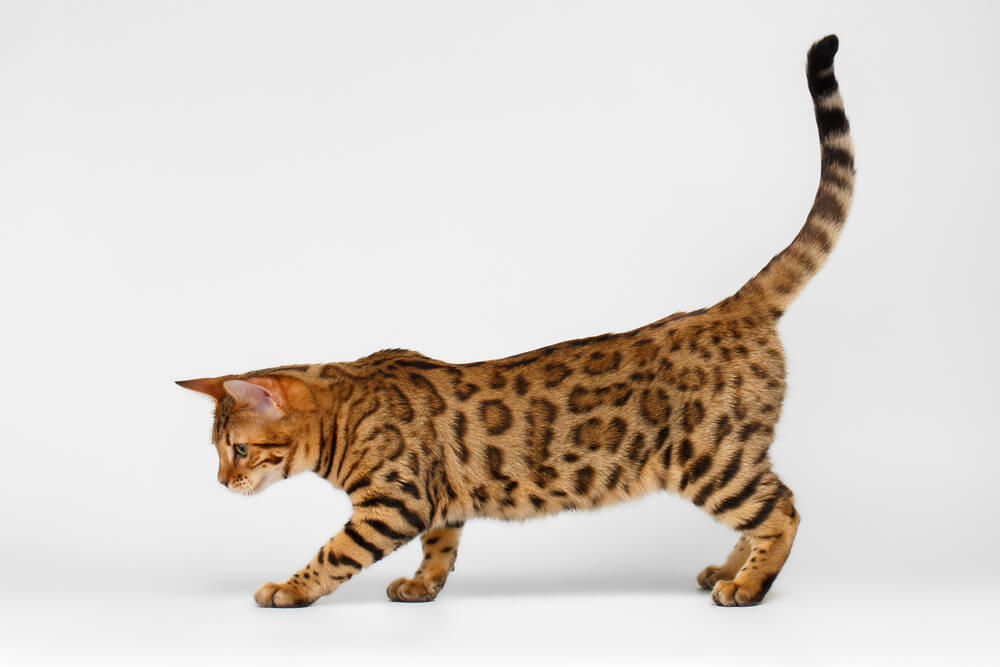
Tail signals are an important part of your cat’s communication repertoire. This article aims to explain more about cats’ tails and tail movements so that you are better equipped to understand what your cat is saying to you with body language using this complex, subtle and expressive part of their anatomy.
Cat Tail Anatomy
The tail is an extension of the spine: while the human spine stops at our pelvis, in animals, including cats, the spine continues backward for another 18 to 23 small bones, or 20 to 30cm.
The average female cat’s tail measures 25cm (10 inches), and the average male cat’s tail measures 28cm (11 inches), with larger breeds like Maine Coons having tails up to 40cm (16 inches) long. The tail can be narrow (in smaller, short-haired cats) or it can be thicker (in larger, long-haired cats like Persians).
The bones of the tail are covered in layers of connective tissue, blood vessels, muscle, skin, and fur. The tail has a rich supply of nerves, giving cats the ability to make their tail move in small and large ways. A cat’s tail can twitch or quiver almost invisibly, or it can move like a whip to strike with strength.
Cat Tail Positions Chart
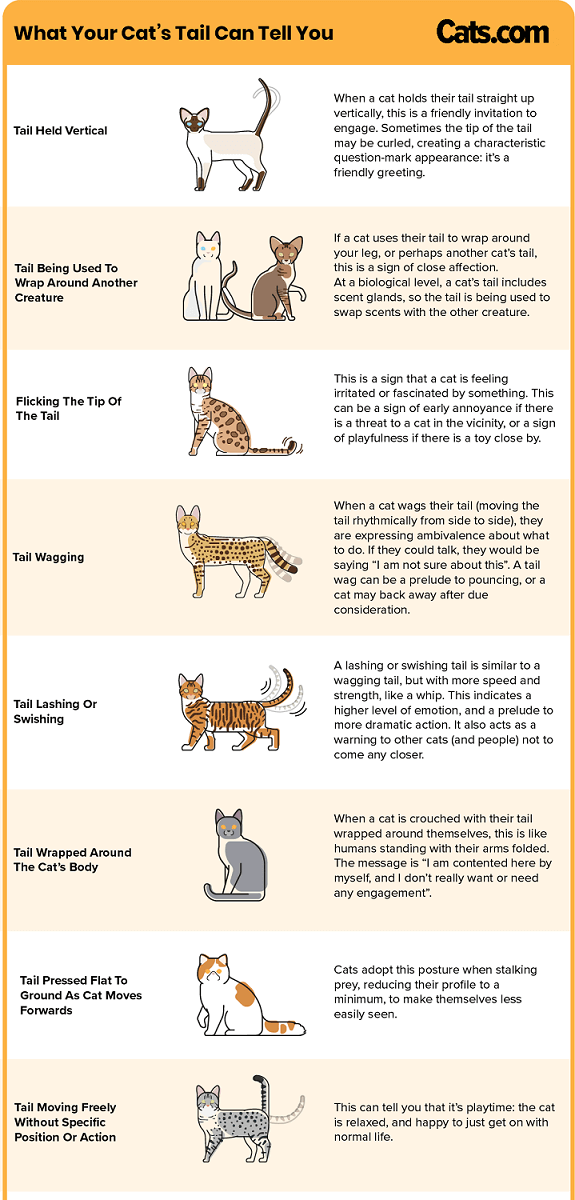
Domestic cats use their tails in a range of different ways to communicate with other cats, and with humans.
Cat tail language can tell you about a cat’s moods, their emotions, and their intentions, allowing you to understand and predict a cat’s behavior. The movement of the tail can tell you as much as a purr, a meow or a yowl.
A tail can move in an almost infinite range of combinations of movements, but the following tail positions are the most common ways that a cat may use their tail to communicate.
1. Tail Held Vertical
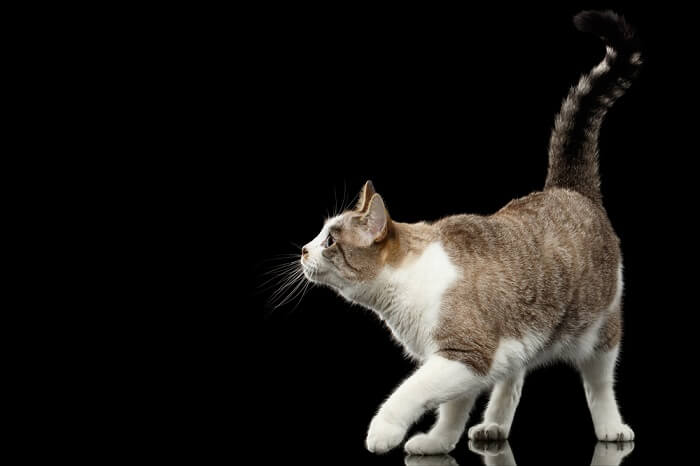
A tail held high with a “question mark” curve at the tip is friendly and usually in a good mood.
What does it mean when a cat’s tail is up? When a cat holds their tail straight up vertically, this is a friendly invitation to engage: anatomically speaking, the cat is exposing their anal sac region, inviting other cats to sniff this area as a type of intimate social engagement.
Sometimes the tip of the tail may be curled, creating a characteristic question-mark appearance.
Pet owners can relax when cats approach them with their tail high in this position: it’s a friendly greeting. Your cat is saying “I’m your feline friend”. A question mark tail may be accompanied by purring,
2. Tail Being Used to Wrap Around Another Creature
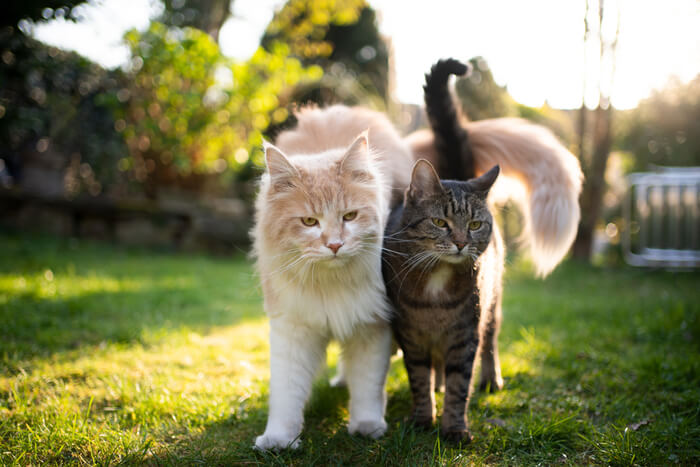
When a cat wraps their tail around a person or animal, it is usually a sign of affection.
If a cat uses their tail to wrap around your leg, or perhaps another cat’s tail, this is a sign of close affection.
At a biological level, a cat’s tail includes scent glands, so the tail is being used to swap scents with the other creature. This is similar to head-pressing and cheek-rubbing, and it’s as if the cat is petting you, in the same way as you pet them when you want to engage.
3. Flicking the Tip of the Tail
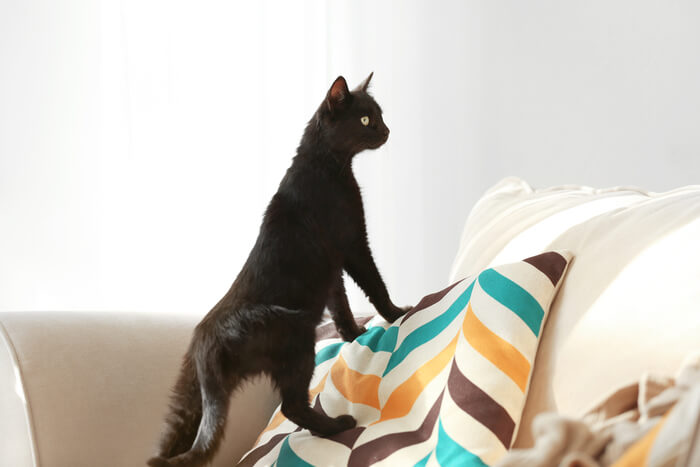
A flicking tip of the tail may indicate irritation or curiosity.
This is a sign that a cat is feeling irritated or fascinated by something. Cat owners should scan the cat’s environment to see if they can spot the source of the cat’s attention. This can be a sign of early annoyance if there is a threat to a cat in the vicinity, or a sign of playfulness if there is a toy close by.
4. Tail Wagging
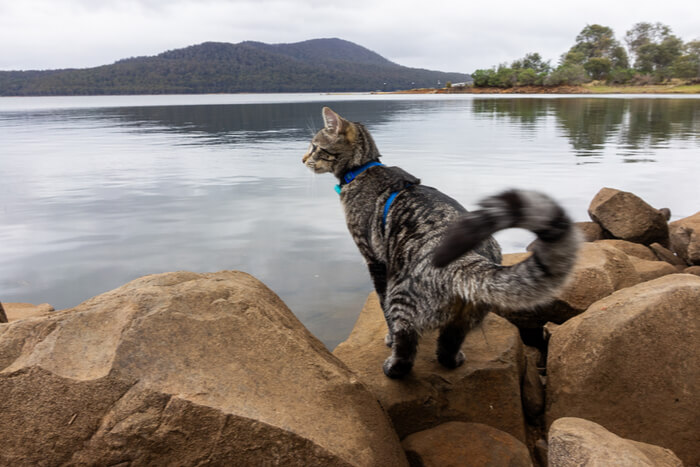
A cat may show ambivalence or uncertainty by slowly wagging their tail.
When a cat wags their tail (moving the tail rhythmically from side to side), they are expressing ambivalence about what to do. If they could talk, they would be saying “I am not sure about this”.
So if a cat is in confrontation with another cat, the tail wags as if to say “will I attack or will I run away?” If a cat is stalking prey, their tail will switch from side to side before they pounce: the message is “will I keep moving slowly or will I leap on them now?”. A tail wag can be a prelude to pouncing, or a cat may back away after due consideration.
5. Tail Lashing or Swishing
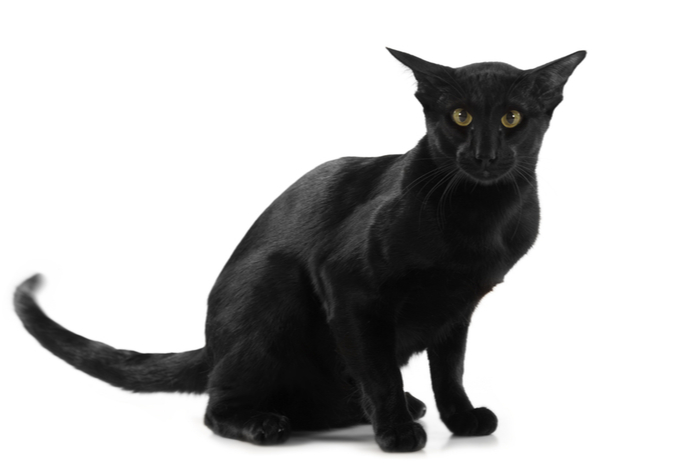
A rapidly swishing tail indicates an upset cat.
A lashing or swishing tail is similar to a wagging tail, but with more speed and strength, like a whip. This indicates a higher level of emotion, and a prelude to more dramatic action.
It also acts as a warning to other cats (and people) not to come any closer. If a cat lashing their tail is approached, or if other cats (or people) do not back off from a cat that is lashing their tail, the cat is likely to attack. The cat will often use vocalization to reinforce the lashing tail, with a yowl or a loud meow to add to the warning.
As a DVM veterinarian, I know to stand back if a cat on my consulting table starts to swish their tail: understanding this type of cat tail message is an important part of practicing safe veterinary medicine.
6. Tail Wrapped Around the Cat’s Body
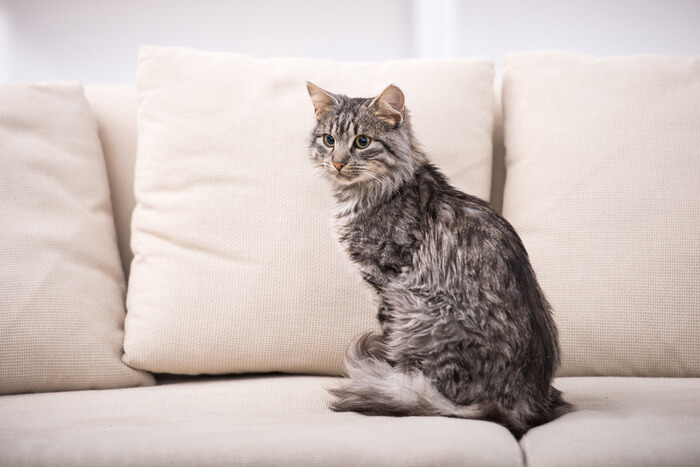
Cats will often wrap their tails around themselves when they are contented and don’t want or need interaction.
When a cat is crouched with their tail wrapped around themselves, this is like humans standing with their arms folded. The message is “I am contented here by myself, and I don’t really want or need any engagement”.
7. Tail Pressed Flat to Ground as Cat Moves Forwards
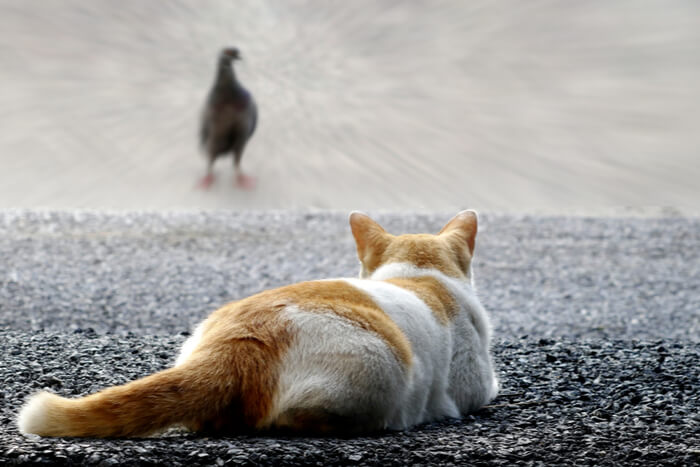
A cat may press their tail to the ground as they stalk their prey.
Cats adopt this posture when stalking prey, reducing their profile to a minimum, to make themselves less easily seen.
8. Tail Moving Freely Without Specific Position or Action
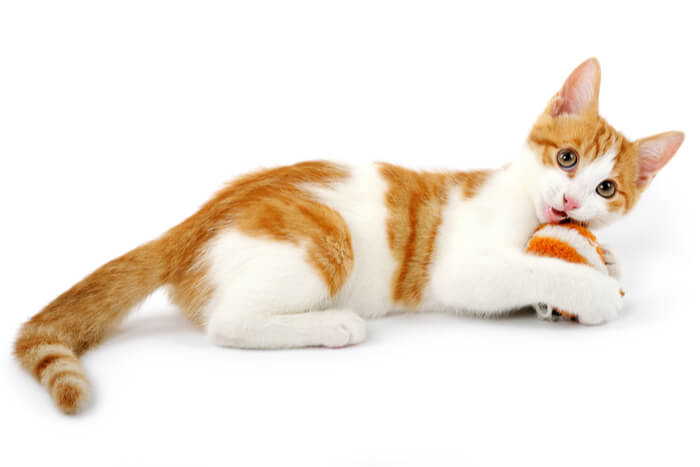
A relaxed tail that isn’t effortfully moving or held in any one position usually indicates a cat who is calm and not focused on any particular mood or thing in their environment.
This can tell you that it’s playtime: the cat is relaxed, and happy to just get on with normal life.
Cats use their tails to communicate subtle – and not so subtle – messages to those around them. If owners take the time to learn about what the various tail messages mean, they will enjoy a richer, closer relationship with their pets.
Frequently Asked Questions
What does it mean if a cat is wagging its tail?
A wagging tail means that the cat is ambivalent: they are pausing for thought, not sure about what to do next.
Why does my cat slap me with his tail?
Whipping or lashing of the tail is a sign that at cat is angry, and that they may take a sudden, strong action in the near future. If a cat does this, it’s time to take a step backwards to give the cat some space. If you don’t, you may risk being bitten or scratched.
Why do cats thump their tails when lying down?
The tail is part of a cat’s balancing equipment, so just as it is used to help cats to walk along narrow surfaces (like a tightrope walker’s bar) it’s also used to keep cats stable and settled when they are lying down. It’s like wrapping a comfortable blanket around themselves, and settling this into place securely.
Why do cats flick their tails?
This could be a sign that a cat is feeling irritated or fascinated by something. Cat owners should scan the cat's environment to see if they can spot the source of the cat's attention.
Why cats wag their tails?
When a cat wags their tail (moving the tail rhythmically from side to side), they are expressing ambivalence about what to do. If they could talk, they would be saying “I am not sure about this”.
do cats have bones in their tails
The tail is an extension of the spine: while the human spine stops at our pelvis, in animals, including cats, the spine continues backward for another 18 to 23 small bones, or 20 to 30cm. The bones of the tail are covered in layers of connective tissue, blood vessels, muscle, skin, and fur


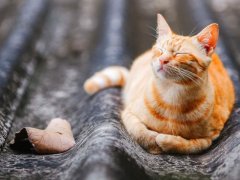

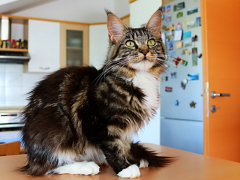

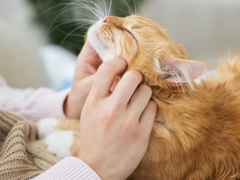
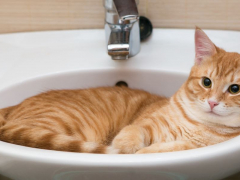
my cat allows me to rub their belly even their balle hehehe they are 3 months old., they are 2 with one stary cat but they all same, like to be petted..
What friendly little cuties!
Thank you. I need input since Santa gave me a 4 month old boy I named Pickles. He is very affectionate and is a wild one. He’s a house cat and I wanted to know if they like having their tail petted. Again, thank you and God Bless!
Aloha,
Lynise Tarring
Why does my male cat sometimes bite while being petted? It’s not a hard bite and he continues rubbing on us for keep on scratching under his chin.
A soft bite like that is often a display of affection—if he just does it gently and then stops, and especially if it only occurs during affectionate moments, I’d be almost certain that it’s one of the ways that your cat shows you he enjoys your company.